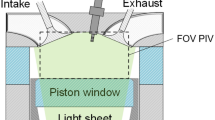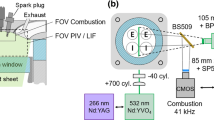Abstract
Previous work demonstrated that the occasional misfired and partially burned cycles (MF) in a stratified-charge, spark-ignited direct injection engine always achieved an early flame kernel, but failed to reach and inflame the fuel in the bottom of the piston bowl. This conclusion was derived from intra-cycle crank angle resolved velocity and fuel concentration images that were recorded simultaneously using high-speed particle image velocimetry and planar laser-induced fluorescence. In this study, both ensemble average analysis, conditionally sampled on either MF or Well Burned (WB) cycles and proper orthogonal decomposition (POD) are applied separately to the velocity and fuel distributions. POD of the velocity and fuel distributions near the spark plug were performed, and the mode energy and structure of the modes are compared. This analysis is used to assess the similarity and differences between the MF and the WB cycles and to identify physical insight gained by POD. The POD modes were determined from the combined set of 200 WB and 37 MF cycles to create two sets of 237 orthogonal modes, one set for the velocity, V, and one for the equivalence ratio, ε. Then, conditionally sampled averages of the POD coefficients could be used to quantify the extent to which each mode contributed to the MFs. Also, the probability density functions of the coefficients quantified the cyclic variability of each mode’s contribution. The application of proper orthogonal decomposition to velocity and equivalence ratio images was useful in identifying and analyzing the differences in flow and mixture conditions at the time of spark between well-burning and misfiring cycles. However, POD results alone were not sufficient to identify which of the cycles were misfiring cycles, and additional information was required for conditional sampling.












Similar content being viewed by others
References
Baby X, Dupont A, Ahmed A, Deslandes W, Charnay G, Michard M (2002) A new methodology to analyze cycle-to-cycle aerodynamic variations. SAE 2002-01-2837
Bizon K, Continillo G, Leistner KC, Mancaruso E, Vaglieco BM (2009) POD-based analysis of cycle-to-cycle variations in an optically accessible diesel engine. Proc Combust Inst 32:2809–2816
Bizon K, Continillo G, Mancaruso E, Merola SS, Vaglieco BM (2010) POD-based analysis of combustion images in optically accessible engines. Combustion and Flame 157:632–640
Chatterjee A (2000) An introduction to the proper orthogonal decomposition. Curr Sci 78:808–817
Cordier L, Bergmann M (2003) Proper orthogonal decompsition: an overview lecture series 2003-04 in VKI, Post-processing of experimental and numerical data
Fajardo CM, Smith JD, Sick V (2006) Sustained simultaneous high-speed imaging of scalar and velocity fields using a single laser. Appl Phys B-Lasers Optics 85:25–30
Fansler T, Drake M, Böhm B (2008) High-speed Mie scattering diagnostics for spray-guided gasoline engine development 8th International symposium on internal combustion diagnostics. AVL, Baden–Baden, Germany
Fogleman M, Lumley J, Rempfer D, Haworth D (2004) Application of the proper orthogonal decomposition to datasets of internal combustion engine flows. J Turbulence 5
Holmes P, Lumley JL, Berkooz G (1996) Turbulence, coherent structures, dynamical systems and symmetry. Cambridge University Press, Cambridge
Holmes PJ, Lumley JL, Berkooz G, Mattingly JC, Wittenberg RW (1997) Low-dimensional models of coherent structures in turbulence. Phys Rep 287:337–384
Liu K, Haworth D (2011) Development and assessment of POD for analysis of turbulent flow in piston engines. SAE Paper 2011-01-0830
Lumley JL (1967) The structure of inhomogeneous turbulence. In: Yaglom AM, Tatarski VI (eds) Atmospheric turbulence and wave propagation, pp 166–178
Peterson B, Sick V (2009) Simultaneous flow field and fuel concentration imaging at 4.8 kHz in an operating engine. Appl Phys B 97:887–895
Peterson B, Reuss DL, Sick V (2011) High-speed imaging analysis of misfires in a spray-guided direct injection engine. Proc Combust Inst 33:3089–3096
Roudnitzky S, Druault P, Guibert P (2006) Proper orthogonal decomposition of in-cylinder engine flow into mean component, coherent structures and random Gaussian fluctuations. J Turbulence 7:1–19
Sick V, Drake MC, Fansler TD (2010a) High-speed imaging for direct-injection gasoline engine research and development. Exp Fluids 49:937–947
Sick V, Reuss D, Rutland C, Haworth D, Oefelein J, Janicka J, Kuo T-W, Freitag XY (2010b) A common engine platform for engine LES development and validation. In: Angelberger C (ed) LES4ICE. IFP Energies Nouvelles, Rueil-Malmaison, France
Sirovich L (1987) Turbulence and the dynamics of Coherent structures.1. Coherent structures. Q Appl Math 45:561–571
Sirovich L, Kirby M (1987) Low-dimensional procedure for the characterization of human faces. JOSA A 4:519–524
Voisine M, Thomas L, Boree J, Rey P (2011) Spatio-temporal structure and cycle to cycle variations of an in-cylinder tumbling flow. Exp Fluids 50:1393–1407
Zhao F, Lai M-C, Harrington DL (1999) Automotive spark-ignited direct-injection gasoline engines. Prog Energy Combustion Sci 25:437–562
Acknowledgments
This work was supported by General Motors R&D within the GM-UM Collaborative Research Laboratory on Engine Systems Research at The University of Michigan. Hao Chen is grateful for financial support from Shanghai Jiao Tong University to enable a ten-month visit to the University of Michigan. Brian Peterson has provided the images on which this analysis is based on. The authors would also like to acknowledge discussions with Professor Min Xu and Yuyin Zhang from Shanghai Jiao Tong University. Finally, we are grateful for comments from an anonymous reviewer of ref. (Peterson et al. 2011) that inspired us to do the work presented here.
Author information
Authors and Affiliations
Corresponding author
Rights and permissions
About this article
Cite this article
Chen, H., Reuss, D.L. & Sick, V. Analysis of misfires in a direct injection engine using proper orthogonal decomposition. Exp Fluids 51, 1139–1151 (2011). https://doi.org/10.1007/s00348-011-1133-z
Received:
Revised:
Accepted:
Published:
Issue Date:
DOI: https://doi.org/10.1007/s00348-011-1133-z




